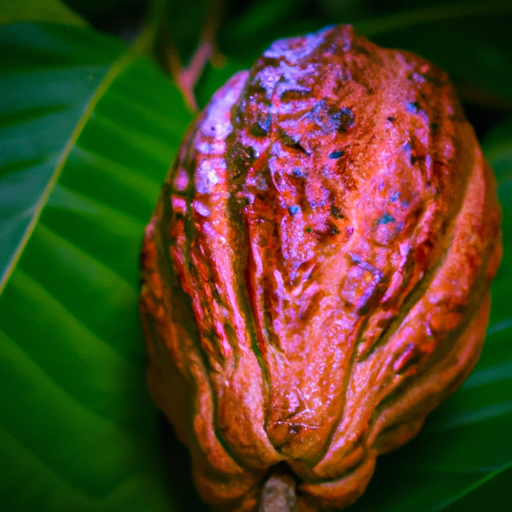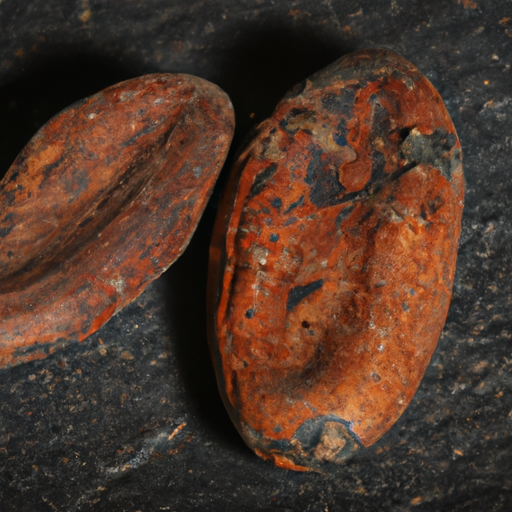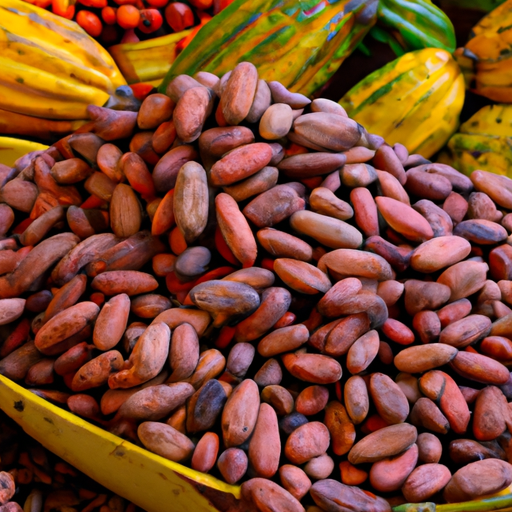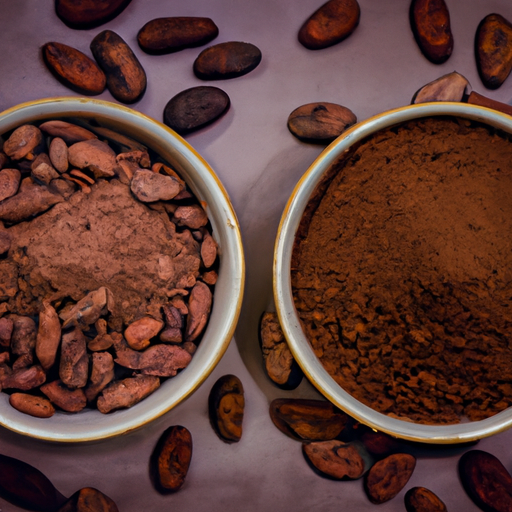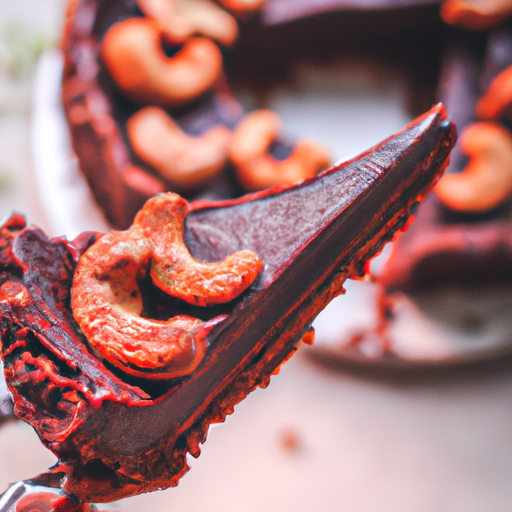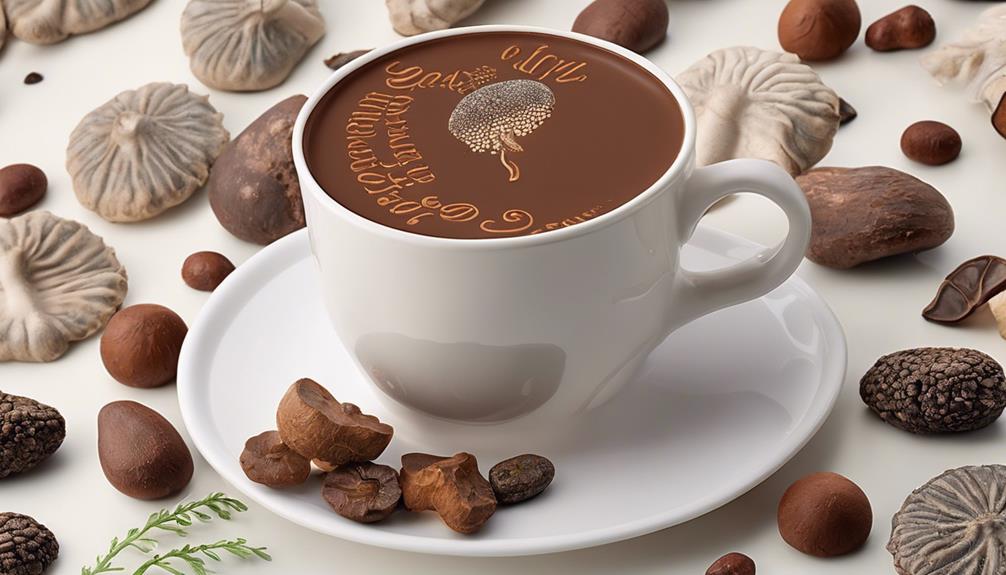Are you aware that raw cacao is considered one of the most nutrient-rich foods in the world? With over 300 chemical compounds, it delivers a strong impact in terms of potential health benefits.
In this article, I will explore what raw cacao is, how it differs from cocoa, and how it is processed. We will also delve into the culinary uses of raw cacao and its distinct flavor profile.
Additionally, I will discuss the importance of ethical and sustainable sourcing when it comes to cacao production. Whether you’re a chocolate lover or simply interested in incorporating more superfoods into your diet, understanding raw cacao is essential.
From exploring different cacao varieties to discovering creative ways to enjoy this incredible ingredient, this article will provide you with all the information you need to make the most of raw cacao in your healthy lifestyle.
So, let’s dive into the world of raw cacao and unlock its hidden treasures.
Key Takeaways
- Raw cacao is one of the most nutrient-dense foods, containing over 300 chemical compounds.
- It is rich in magnesium, iron, and potassium.
- Raw cacao has flavonoids, which are potent antioxidants.
- Cacao and cocoa are different in terms of processing, with cacao referring to the raw form and cocoa undergoing more processing.
The Origins of Cacao
The origins of cacao can be traced back to ancient civilizations. It was highly valued for its medicinal properties and used in sacred ceremonies. Cacao has a rich historical significance and cultural impact. It played a significant role in the lives of these ancient societies.
The cultivation and harvesting techniques of cacao were developed by these civilizations. They recognized the value of the cacao tree and its beans. They understood the importance of carefully tending to the trees and using specific methods to extract the beans. These techniques were passed down through generations, allowing the knowledge of cacao cultivation to spread.
The historical significance of cacao and its cultivation techniques set the stage for the subsequent section about the nutritional benefits of raw cacao. It highlights the long-standing importance of this incredible plant.
Nutritional Benefits of Raw Cacao
Indulging in the delectable richness of unprocessed cacao can be a blissful journey towards nourishing your body with a natural source of antioxidants and essential minerals.
Raw cacao is not only a treat for the taste buds but also a nutritional powerhouse. It is packed with flavonoids, which are potent antioxidants that help protect the body against free radicals and oxidative stress.
Additionally, raw cacao is a rich source of magnesium, iron, and potassium, which are essential minerals that support various bodily functions. From a culinary standpoint, raw cacao can be used in a variety of ways, such as adding it to smoothies, baking it into desserts, or sprinkling it over yogurt.
Transitioning into the subsequent section about ‘the difference between cacao and cocoa’, it is important to understand the distinction between these two terms.
The Difference Between Cacao and Cocoa
Savoring the rich flavor of unprocessed cacao can transport you to a world of culinary delight, but it’s important to understand the distinction between cacao and cocoa.
While cacao and cocoa may sound similar, they are actually different in terms of processing. Cacao refers to the raw form of the bean, which undergoes minimal processing and retains its natural nutrients.
On the other hand, cocoa is the result of a more extensive process that involves roasting, grinding, and sometimes adding sugar or other ingredients. This process reduces the theobromine content, which is a natural compound found in cacao known for its health benefits.
Understanding this difference is vital when choosing products that contain cacao or cocoa.
Now, let’s delve into how raw cacao is processed.
How Raw Cacao is Processed
Get ready to discover the fascinating process of turning the cacao bean into a mouthwatering treat. Raw cacao is processed using various methods to unlock its rich flavors and health benefits.
The first step in processing raw cacao involves carefully harvesting the cacao pods and extracting the beans. These beans are then fermented for several days to develop their characteristic taste.
After fermentation, the beans are dried, usually under the sun, to reduce moisture content. Once dried, the beans are roasted at low temperatures to enhance their flavors.
The roasted beans are then ground into a fine powder, which can be used in a variety of culinary applications.
From its harvesting to the final product, the processing methods of raw cacao ensure that it retains its nutritional properties and distinct taste.
Now let’s explore the culinary uses of raw cacao.
Culinary Uses of Raw Cacao
When it comes to culinary uses, raw cacao can be a versatile ingredient in various recipes. One can explore the world of raw chocolate recipes, where the unique flavors and health benefits of cacao can be fully appreciated.
Additionally, cacao-based beverages offer a rich and indulgent experience, whether it’s a creamy hot chocolate or a refreshing chocolate smoothie.
Lastly, incorporating raw cacao in desserts and baking opens up a realm of possibilities, from decadent cakes to chewy brownies, where the distinct taste of cacao can shine through.
Raw chocolate recipes
Indulge in some mouthwatering raw chocolate recipes that will make your taste buds dance with delight as you discover the hidden wonders of cacao raw. Here are three delightful ways to incorporate raw cacao into your culinary repertoire:
-
Raw Chocolate Smoothies: Blend together frozen bananas, almond milk, a spoonful of raw cacao powder, and a touch of honey. This creamy and indulgent treat will satisfy your chocolate cravings.
-
Raw Cacao Energy Balls: Combine dates, almonds, raw cacao powder, and a pinch of sea salt in a food processor. Roll the mixture into bite-sized balls and refrigerate for a quick and nutritious snack packed with antioxidants and natural energy.
-
Raw Chocolate Avocado Mousse: Blend ripe avocados, raw cacao powder, maple syrup, and a splash of vanilla extract until smooth and creamy. Serve chilled for a decadent and healthy dessert option.
These raw chocolate recipes are just the beginning of the delicious possibilities that cacao raw can offer.
In the next section, we will explore the world of cacao-based beverages.
Cacao-based beverages
In my previous section on raw chocolate recipes, I explored the delicious possibilities of using cacao in its unprocessed form to create mouthwatering treats. Now, let’s shift our focus to cacao-based beverages, which offer a unique and invigorating way to enjoy the rich flavors and health benefits of this superfood. To help you understand the versatility of cacao in beverages, I have prepared a table showcasing three delicious cacao recipes, along with their key ingredients and health benefits. By incorporating cacao into your drinks, you can indulge in its antioxidant properties, which can help improve cardiovascular health and boost your mood. Now that we have explored cacao-based beverages, let’s dive into the next section on how cacao can elevate desserts and baking, without missing a beat.
Cacao in desserts and baking
Get ready to take your desserts and baking to the next level with the incredible versatility of cacao. Raw cacao, with its intense flavor and rich nutrients, can be a game changer in the world of desserts.
Here are four ways to incorporate raw cacao into your baking:
-
Raw cacao powder: Replace regular cocoa powder with raw cacao powder to add a deep, complex flavor to your cakes, cookies, and brownies.
-
Raw cacao nibs: Sprinkle raw cacao nibs on top of your desserts for a delightful crunch and a burst of intense chocolate flavor.
-
Raw cacao butter: Use raw cacao butter as a substitute for regular butter in your recipes to create a velvety texture and a decadent taste.
-
Raw cacao paste: Melt raw cacao paste and mix it into your dessert recipes for a smooth and luxurious chocolatey experience.
With these raw cacao options, you can elevate the taste and nutritional value of your desserts.
Transitioning into the subsequent section about the flavor profile of raw cacao, you’ll discover the fascinating nuances that make this ingredient truly unique.
The Flavor Profile of Raw Cacao
When it comes to the flavor profile of raw cacao, there are a few key points to consider.
Firstly, raw cacao is known for its intense bitterness and complexity, which is a result of its high concentration of natural compounds like polyphenols and flavonoids.
Secondly, raw cacao exhibits a range of tasting notes and aromas, including hints of fruitiness, nuttiness, and earthiness.
Lastly, when it comes to pairings and flavor combinations, raw cacao can be a versatile ingredient that pairs well with ingredients like berries, nuts, and spices, allowing for a myriad of creative culinary possibilities.
Bitterness and complexity
Biting into a piece of raw cacao, your taste buds experience an explosion of bitter notes and a lingering complexity. This bitterness, more pronounced than that found in coffee, has a purpose. It results from the high concentration of polyphenols in cacao, known for their antioxidant properties and potential health benefits. The bitterness also gives dark chocolate its signature taste. However, the complexity of raw cacao extends beyond bitterness. It offers hints of fruity, floral, and earthy flavors that add depth to its profile. In the next section, we will explore these tasting notes and aromas, allowing you to fully appreciate the complexity of raw cacao.
Tasting notes and aromas
The taste of dark chocolate is enhanced by the complex combination of fruity, floral, and earthy flavors, creating a rich and indulgent experience for the palate. When tasting cacao raw, it is important to use proper tasting techniques to fully appreciate its flavors and aromas. To begin, break off a small piece and let it melt on your tongue, allowing the flavors to develop. Take note of the initial taste and any changes that occur as it melts. Some common tasting notes in raw cacao include hints of red berries, citrus, and even tobacco. These flavors can vary depending on the origin of the cacao bean. To further elevate your experience, consider flavor pairings such as coffee, red wine, or even chili peppers, as they can complement the complex flavors of cacao. Moving on to the next section about ‘pairings and flavor combinations’, we explore how different ingredients can enhance the taste of cacao.
Pairings and flavor combinations
To truly elevate the taste of dark chocolate, one must explore the art of pairing and experimenting with different flavors. Pairing dark chocolate with the right flavors can create a harmonious and complex taste experience. Here are three flavor combinations that will take your dark chocolate indulgence to the next level:
-
Sea salt: The combination of the rich, bitter notes of dark chocolate with the delicate saltiness of sea salt creates a perfect balance of flavors that tantalizes the taste buds.
-
Raspberry: The tartness of raspberries complements the sweetness of dark chocolate, creating a delightful contrast that enhances both flavors.
-
Espresso: The robust flavor of espresso adds depth and intensity to dark chocolate, resulting in a bold and indulgent combination that coffee lovers will adore.
By exploring these pairings and flavor combinations, you can unlock a world of taste sensations that will elevate your dark chocolate experience.
Moving onto the next section about ethical and sustainable sourcing of cacao, it is important to consider the origin of the cacao beans and the impact of our choices on the environment and the communities involved.
Ethical and Sustainable Sourcing of Cacao
Sourcing cacao ethically and sustainably ensures the preservation of livelihoods and ecosystems. Ethical sourcing involves promoting fair trade practices, ensuring that farmers are paid a fair price for their cacao beans and are not exploited. It also involves supporting farmers who use environmentally friendly farming practices, such as agroforestry, which helps to maintain biodiversity and reduce deforestation.
Sustainability in cacao sourcing means that the process is environmentally sustainable, economically viable, and socially responsible. This includes minimizing the use of chemicals, conserving water resources, and promoting the well-being of the communities involved.
By sourcing cacao ethically and sustainably, we can contribute to the long-term viability of the cacao industry and support the livelihoods of farmers. Incorporating raw cacao into a healthy lifestyle allows us to reap the numerous health benefits it offers, while also supporting ethical and sustainable practices in the cacao industry.
Incorporating Raw Cacao into a Healthy Lifestyle
When it comes to incorporating raw cacao into a healthy lifestyle, moderation and portion control are key.
While cacao offers a range of health benefits, consuming it in excess may lead to negative effects such as increased heart rate and blood pressure.
It’s important to balance cacao consumption with other nutrient-rich foods to ensure a well-rounded diet.
Additionally, individuals should be aware of potential allergenicity and sensitivities to cacao, as some people may experience adverse reactions.
Moderation and portion control
Achieving a healthy balance is key when it comes to enjoying the rich flavors of cacao raw. Moderation is necessary to fully reap the health benefits of this superfood. Here are four tips to help you incorporate raw cacao into your diet in a mindful way:
-
Portion control: Limit your intake to recommended serving sizes to avoid overconsumption of calories and stimulants.
-
Listen to your body: Pay attention to how cacao makes you feel. If you experience any negative effects like jitteriness or sleep disturbances, adjust your intake accordingly.
-
Combine with other nutrient-dense foods: Pairing cacao with fruits, nuts, or yogurt can enhance its nutritional value and provide a well-rounded snack or dessert.
-
Diversify your sources: Explore different forms of cacao, such as nibs, powder, or dark chocolate, to enjoy a variety of flavors and textures.
By practicing moderation and exploring different ways to enjoy cacao, you can find a healthy balance that complements your overall diet and lifestyle.
Now, let’s delve into balancing cacao consumption with other foods.
Balancing cacao consumption with other foods
To fully enjoy the rich flavors of cacao, it’s important to find a healthy balance by incorporating it into your diet alongside other nutritious foods. Balancing cacao intake with a variety of foods ensures that you receive all the necessary nutrients for optimal health. Cacao is a good source of magnesium, iron, and antioxidants, but it should not be the sole focus of your diet. By pairing cacao with fruits, vegetables, whole grains, and lean proteins, you can create a well-rounded meal that provides a range of vitamins, minerals, and other beneficial compounds.
To illustrate the importance of balance, consider the following table:
| Food | Nutrient Content |
|---|---|
| Cacao | High in antioxidants |
| Fruits | Rich in vitamins |
| Vegetables | High in fiber |
By incorporating these foods into your diet, you can ensure that you are meeting your nutritional needs while still indulging in the flavors of cacao.
Transitioning into the next section about potential allergenicity and sensitivities, it is important to be aware of any adverse reactions that may occur when consuming cacao.
Potential allergenicity and sensitivities
Incorporating a variety of foods into your diet ensures that you receive all the necessary nutrients for optimal health. However, it’s important to be aware of potential allergenicity and sensitivities when enjoying the rich flavors of cacao.
When it comes to cacao, some individuals may experience allergic reactions or sensitivities. It’s crucial to identify and understand these potential issues to avoid any adverse effects. Here are some important points to consider:
-
Some people may be allergic to cacao or have sensitivities to it, resulting in symptoms like hives, itching, or digestive discomfort.
-
Cacao contains compounds such as theobromine and phenylethylamine, which may trigger migraines in susceptible individuals.
-
Alternative uses of cacao, such as cacao butter or cacao powder, may be better tolerated by those with sensitivities.
-
Moderation is key when consuming cacao to minimize the risk of adverse effects.
-
It’s always recommended to consult with a healthcare professional if you have any concerns or known allergies before incorporating cacao into your diet.
Now, let’s explore the different varieties and products of cacao to further expand our knowledge.
Exploring Cacao Varieties and Products
When exploring cacao varieties and products, it’s important to understand the different types of cacao beans available. These beans can vary in flavor profiles and are categorized based on their origin and genetic makeup.
Cacao nibs, powder, and butter are popular products derived from cacao beans. Each of these products offers unique culinary possibilities and health benefits.
Artisanal and specialty cacao products are also gaining popularity. These products provide consumers with a wider range of options to enhance their cacao experience.
Different types of cacao beans
Did you know that there are various types of cacao beans, each with its own unique flavor profile and characteristics? When it comes to cacao, the fermentation process plays a crucial role in determining the flavor and aroma of the final product. Different types of cacao beans undergo different fermentation methods, resulting in distinct flavor profiles. For instance, Criollo cacao beans are known for their delicate and complex flavors, while Forastero beans tend to have a more robust and bitter taste. Trinitario cacao beans, on the other hand, offer a balance between the two. To better understand the differences, take a look at the table below that summarizes the flavor profiles of the main cacao bean types:
| Cacao Bean Type | Flavor Profile |
|---|---|
| Criollo | Delicate, complex |
| Forastero | Robust, bitter |
| Trinitario | Balanced |
Now that you have learned about the different types of cacao beans and their flavor profiles, let’s move on to explore cacao nibs, powder, and butter.
Cacao nibs, powder, and butter
Now, let’s dive into the world of cacao nibs, powder, and butter and discover their incredible versatility and mouthwatering potential.
Cacao nibs are small pieces of crushed cacao beans that are roasted and fermented. They have a deep, intense chocolate flavor and a crunchy texture.
Cacao powder, on the other hand, is made by grinding the roasted cacao beans into a fine powder. It is often used in baking, smoothies, and hot beverages.
Cacao butter is the fat extracted from the cacao bean and has a rich, creamy texture. It is commonly used in chocolate making and as a moisturizing ingredient in cosmetics.
In addition to their culinary applications, cacao nibs, powder, and butter also offer numerous health benefits, such as being a good source of antioxidants and minerals. They can improve heart health, boost mood, and promote healthy digestion.
Transitioning into the next section about artisanal and specialty cacao products, these versatile ingredients serve as the foundation for creating a wide range of unique and indulgent treats.
Artisanal and specialty cacao products
Now that we have explored the various forms of cacao, let’s delve into the world of artisanal and specialty cacao products. These unique creations are crafted with utmost care and expertise, resulting in exceptional flavors and textures. Artisanal cacao products are often made by small-scale producers who prioritize quality and sustainability in their farming practices. By focusing on traditional methods and choosing the finest cacao beans, these producers ensure that their products stand out in terms of taste and quality.
Cacao farming practices play a crucial role in the production of these specialty products. Farmers who adopt sustainable practices, such as organic cultivation and fair trade principles, contribute to the overall health of the cacao ecosystem and the well-being of the farmers themselves.
Furthermore, the health benefits of cacao are widely recognized. Rich in antioxidants, cacao offers numerous potential health advantages, including improved brain function, heart health, and mood enhancement. These benefits, combined with the artisanal touch, make specialty cacao products a truly remarkable indulgence.
| Emotion | Cacao Products | Cacao Farming Practices |
|---|---|---|
| Excitement | Exquisite | Sustainable |
| Intrigue | Unique | Organic |
| Satisfaction | Indulgent | Fair trade |
Frequently Asked Questions
Can raw cacao be used as a substitute for cocoa powder in baking recipes?
Yes, raw cacao can be used as a substitute for cocoa powder in baking recipes. It provides similar flavor and texture. Additionally, raw cacao offers numerous health benefits, such as being rich in antioxidants and minerals.
Is raw cacao suitable for individuals with lactose intolerance or dairy allergies?
Raw cacao is a suitable option for individuals with lactose intolerance or dairy allergies since it is naturally dairy-free. It can be used as a substitute for cocoa powder in baking recipes without causing any adverse reactions.
What is the recommended daily intake of raw cacao for optimal health benefits?
To achieve optimal health benefits, the recommended daily intake of raw cacao varies depending on factors such as age and overall health. Incorporating raw cacao into a balanced diet can provide various health benefits.
Are there any potential side effects or risks associated with consuming raw cacao?
Potential side effects of consuming raw cacao include digestive issues, such as diarrhea and stomach cramps, due to its high fiber content. Additionally, the caffeine and theobromine in cacao may cause jitteriness, increased heart rate, and sleep disturbances.
How does the taste of raw cacao differ from regular chocolate?
Raw cacao has a distinct taste that is more bitter and intense compared to regular chocolate. It retains its natural flavors and nutrients, providing various health benefits such as antioxidants, minerals, and mood-enhancing properties.
Does Microwaving Raw Cacao Change Its Nutritional Value or Benefits?
Microwaving raw cacao effects its nutritional value and benefits. The high heat can reduce the antioxidant content and lower the overall health benefits of raw cacao. It’s best to consume raw cacao in its natural, unheated state to get the maximum nutritional value.
Conclusion
In conclusion, raw cacao is a delicious and nutritious superfood. It offers a wide range of health benefits. Raw cacao has stood the test of time, from its origins in ancient civilizations to its modern culinary uses. Incorporating raw cacao into a healthy lifestyle is a wise choice, given its rich flavor profile and ethical sourcing practices. So why not indulge in the heavenly taste of raw cacao? Unlock the secrets of this heavenly bean and explore the world of cacao. It is ready to tantalize your taste buds and nourish your body. Remember, as the saying goes, ‘A little cacao goes a long way.’

